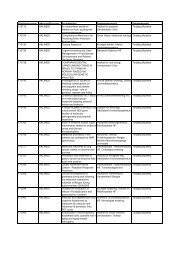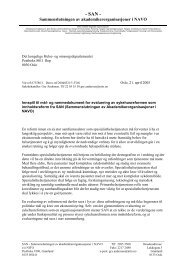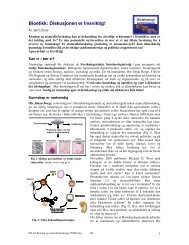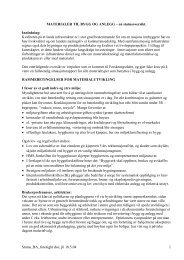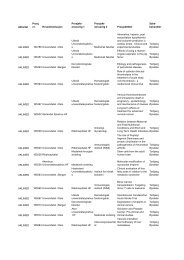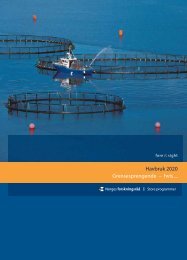A Revolution in R&D
A Revolution in R&D
A Revolution in R&D
You also want an ePaper? Increase the reach of your titles
YUMPU automatically turns print PDFs into web optimized ePapers that Google loves.
18<br />
trials, if the company were able to decide <strong>in</strong> just one<br />
out of ten such cases to abandon development earlier,<br />
it could save an additional $100 million per<br />
drug.<br />
Improv<strong>in</strong>g decision mak<strong>in</strong>g to that extent will take<br />
more than simply acquir<strong>in</strong>g and implement<strong>in</strong>g the<br />
new genomics technologies and approaches. It will<br />
take some serious strategic reth<strong>in</strong>k<strong>in</strong>g too, and possibly<br />
major organizational changes. Whether to keep<br />
all activities <strong>in</strong>-house, or seek partners, or buy <strong>in</strong> targets<br />
or leads. How to redistribute resources, reassign<br />
personnel, and revise l<strong>in</strong>es of communication and<br />
cha<strong>in</strong>s of command. Such operational and organizational<br />
quandaries will be addressed <strong>in</strong> detail <strong>in</strong> the<br />
f<strong>in</strong>al chapter of this report.<br />
We implemented a fast-<strong>in</strong>/fast-out decision policy<br />
about projects—if we didn’t have optimal conditions<br />
met <strong>in</strong> 18 months, we killed it. That made all<br />
the difference.<br />
—Former executive,<br />
lead<strong>in</strong>g pharmaceutical company<br />
Even the basic bus<strong>in</strong>ess skill of decision mak<strong>in</strong>g,<br />
then, is not immune to the <strong>in</strong>fluence of genomics<br />
technology. Whatever other benefits it br<strong>in</strong>gs,<br />
genomics serves as a wake-up call across the <strong>in</strong>dustry,<br />
even for companies try<strong>in</strong>g to shelter from the<br />
genomics revolution.<br />
The Challenges<br />
Although implement<strong>in</strong>g genomics offers companies<br />
great opportunities, it also presents them with<br />
formidable challenges. One of these is to ensure<br />
that the quality of the pipel<strong>in</strong>e rema<strong>in</strong>s uncompromised.<br />
Another is to put the new technologies <strong>in</strong>to<br />
efficient operation.<br />
Ma<strong>in</strong>ta<strong>in</strong><strong>in</strong>g Quality<br />
If the potential productivity ga<strong>in</strong>s are to be fully<br />
realized, the post-genomics R&D pipel<strong>in</strong>e will need<br />
to reta<strong>in</strong> or improve its pre-genomics quality. Any<br />
decl<strong>in</strong>e <strong>in</strong> quality—the quality of targets and<br />
leads—would obviously have an adverse effect on<br />
productivity. The ma<strong>in</strong> threat to quality derives<br />
from the unorthodoxy, the unfamiliar nature, of so<br />
many new targets. Entire target classes, previously<br />
unknown, will need <strong>in</strong>vestigat<strong>in</strong>g. The temptation<br />
to pursue leads prematurely is bound to arise, and<br />
quality control will need to be rigorously enforced<br />
to uphold the pipel<strong>in</strong>e’s usual success rates.<br />
In any given experiment, 70 percent of what I see is<br />
completely new. It could be a gold rush, or it could<br />
be junk—-there’s no way to tell until I sit at the<br />
bench and do more work.<br />
—Director of research,<br />
lead<strong>in</strong>g biotech company<br />
To appreciate the threat accurately, we need a<br />
proper def<strong>in</strong>ition of the term quality.<br />
The “<strong>in</strong>tr<strong>in</strong>sic quality” of a target or lead amounts<br />
to its likelihood of success, which is based on factors<br />
such as cl<strong>in</strong>ical relevance and drugability.<br />
Companies can do little to alter this type of quality.<br />
The “provisional quality” (or “<strong>in</strong>formational quality”)<br />
of a target or lead is based on the amount of<br />
data available on it at any given time—how much is<br />
known about its cl<strong>in</strong>ical relevance, drugability, and<br />
so on. (This <strong>in</strong>formational quality helps to predict<br />
success rates, but does not <strong>in</strong>fluence them.)<br />
Companies can alter this type of quality, by spend<strong>in</strong>g<br />
appropriately, and <strong>in</strong> that way can improve their<br />
ability to predict downstream success rates.<br />
This dist<strong>in</strong>ction is crucial. But it has at times been<br />
overlooked, result<strong>in</strong>g <strong>in</strong> some confusion <strong>in</strong> the<br />
<strong>in</strong>dustry. A widely publicized concern has been that<br />
novel targets identified through genomics would<br />
tend to be of <strong>in</strong>herently lower quality than pregenomics<br />
targets, and thus more likely to fail at<br />
some costly phase downstream. That <strong>in</strong>ference is an<br />
oversimplification, and is mislead<strong>in</strong>g.<br />
Certa<strong>in</strong>ly genomics proposes many more novel targets<br />
(as much as 60 to 70 percent of potential targets,<br />
<strong>in</strong> our <strong>in</strong>terviewees’ experience, may belong<br />
to previously unknown target classes), and their<br />
<strong>in</strong>formational quality at that early stage is duly modest.<br />
But that says noth<strong>in</strong>g about their <strong>in</strong>tr<strong>in</strong>sic quality.<br />
Any prudent company, no matter how bold, will<br />
strive to learn more about novel targets before<br />
decid<strong>in</strong>g to pursue them downstream. In our analysis,<br />
<strong>in</strong>vestments made to raise a novel target’s <strong>in</strong>for-



